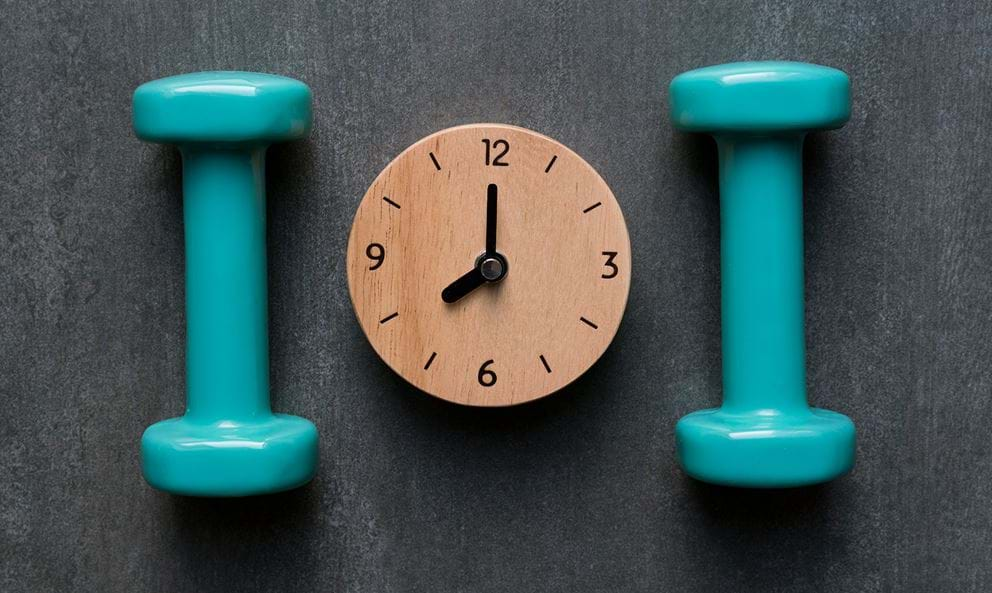How Much Time Should I Be Spending in the Gym?

One of the big questions to ask when figuring out how to properly structure a workout, is “just how long should my training sessions last?”
While the specifics are likely to vary based on individual factors, the intensity of the training, the event that you’re training for and so on, there are a few good rules of thumb you can follow.
Let’s take a look at the main types of workouts:
Conventional strength training
General aerobic sessions: up to 60 minutes

While aerobic exercise is a great thing to do for your overall health, fitness, and wellbeing, there are some pretty good reasons not to let your training sessions creep over the 1-hour mark too often.
A 2005 study which looked at the effects of 40, 80, and 120-minute moderate-intensity treadmill sessions, found that testosterone levels started to fall after about the first hour of training — and then kept declining for the next 3 hours of recovery.
The study also found that the 120-minute session caused an increase in the levels of the stress hormone cortisol. While cortisol is needed for your body to function properly, elevated levels have been linked to obesity, and other symptoms like negative impact on performance and memory.
The researchers concluded that the 40-minute session seemed to have the best overall effects on the ratio of anabolic hormones to cortisol in the body.
In other words; cardio sessions which run to over an hour are likely to make you more stressed, less able to build muscle effectively, and can negatively affect your testosterone levels. When training, it's important to keep in mind the level of intensity you stick to during long cardio sessions.
HIIT sessions: around 10 minutes

HIIT, or High-Intensity Interval Training, is famous for its ability to get you fit in a fraction of the time that a conventional steady-state cardio workout would take.
One 2016 study compared two groups of trainees, one doing a 10-minute HIIT workout 3 times a week, and the other doing a 45-minute steady-state cardio session 3 times a week.
The HIIT group worked out for 3 sets of 20-second sprints, separated by 2-minutes of slow-paced recovery peddling.
By the end of the study, both groups experienced nearly identical fitness benefits.
While there’s often the temptation to draw out HIIT sessions for a greater overall effect, less is generally more with this strenuous type of training. One 1994 study induced acute overtraining in subjects by having them do 2 HIIT sessions per day for 10 days in a row. Side effects included poor mood, reduced performance, and sleep issues, among other things. When training at a higher intensity, it's important to consider that this will likely effect the time your body needs to recover, so make sure to give your body the rest it needs.
Conventional strength training: 30-60 minutes

For the sake of optimising your hormones, it may be beneficial to keep your strength training sessions to around 30-60 minutes. There are other potential benefits to keeping these sessions short and sweet, as well.
For one thing, there is some research out there to suggest that doing single sets might be as effective as doing multiple sets, in terms of strength of and muscle growth. While this shouldn’t be taken as gospel, it’s likely that the importance of high-volume training is sometimes overstated.
Keeping strength training sessions short and punchy may also be a good way of preventing overtraining, as long, high-volume training sessions are often associated with central nervous fatigue that can lead to reduced performance, illness, and mood issues. When it comes to strength training, try to focus on quality over quantity, and have a plan so that you can make your gym time most optimal.
In summary, there is no exact set time as to how long you should be training but these are the general guidelines that you could work from. The important thing is to stick to a workout duration that works for your lifestyle, is tailored towards your goals and is one that you enjoy or can stick to.
Looking for workout ideas? Check out our free video workouts here!


